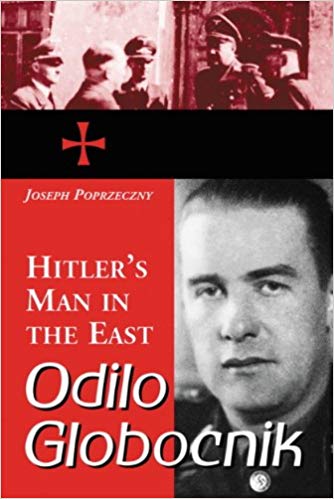Polokaust Zamosc Operation Detail Poprzeczny

Odilo Globocnik: Hitler’s Man in the East, by Joseph Poprzeczny. 2015
The Polokaust: “Operation Zamosc” a Practice Run of GENERALPLAN OST–The Eventual Extermination of Tens of Millions of Poles and Other Slavs
In this book, there are numerous biographical details given about Globocnik, especially his early life, but these are overshadowed by this study of his anti-Jewish and anti-Polish policies. This is probably the best English-language study of GENERALPLAN OST in theory and in action.
LONG-TERM GERMAN GENOCIDAL AMBITIONS AGAINST THE SLAVIC PEOPLES
The German dream of removing all the indigenous Polish people and the Jews, and replacing them with ethnic Germans, long predated the Nazis: e. g., Adolf Bartels, Heinrich von Class, Paul de Lagarde, and Otto von Bismarck. (p. 144) On August 22, 1939, Hitler said: “Poland will be depopulated and then settled by Germans…Who, after all, speaks today of the annihilation of the Armenians?” (p. 161) “To the Poles, Globocnik was yet another Germanic Margrave set on finally destroying them…” (p. 332)
GERMANS WERE “NICER” TO POLES THAN JEWS–FOR PRACTICAL REASONS
Poprzeczny hints at why the Germans usually treated Jews and Poles differently: “The administration of Dr. Hans Frank sought quite vigorously to see rural parts of Poland become a productive force in the overall German scheme of things. That administration did not seek to see the Poles tormented to the point of inflaming resistance, which Globocnik and von Mohrenschildt did provoke after November 1942, launching their cleansing of the Zamosc Lands with Himmler’s concurrence.” (p. 199)
“OPERATION ZAMOSC” AND THE SUCCESSFUL POLISH GUERILLA RESISTANCE THAT STOPPED IT
In “Operation Zamosc”, the Germans removed up to 200,000 Poles (p. 237) from nearly 300 villages (p. 182). Most of the Poles were sent to Germany for forced labor, while others were murdered locally or in death camps. Polish guerilla warfare, especially the BCh (Bataliony Chlopskie: Peasant Battalions) and the AK (Armia Krajowa: Home Army) grew in intensity and became the “Zamosc Uprising”. (pp. 182-183). The Germans tried to suppress it with increasing brutality, but eventually the Polish guerillas got the upper hand (p. 190), and this, plus German reverses on the eastern front, put a stop to this operation.
The genocide of Poles in Volhynia in 1943 by the UPA (so-called Ukrainian Insurgent Army) is blamed by some Ukrainians on the Poles having first attacked innocent Ukrainian settlements in Hrubieszow in 1942. They were anything but! The Ukrainian officials and “settlers” had been collaborating with the Germans and their de-Polonization actions. (pp. 181-182, 190-191, 317, 320-323, etc.). (In addition, Polish actions against Ukrainian settlements were trivial in scale compared with the UPA’s genocide against Poles).
THE POLOKAUST AND GENERALPLAN OST
GENERALPLAN OST, of which “Operation Zamosc” had been merely a foretaste, had called for the resettlement of 100 million Slavs (p. 3), including 21 million Poles, to desolate western Siberia. But how could western Siberia, even with expensive development, possibly support so many people? Note that early plans for “Jewish reservations” (e. g., pp. 148-149, 154-155, 217) had to be abandoned as unrealistic, giving way to extermination. So how could the equally-unrealistic Slav-reservation plans fail to eventually follow the same course? For elaboration, see the Peczkis review of Hans Frank, Lebensraum and the Holocaust.
To see a series of truncated reviews in a Category click on that Category:
- All reviews
- Anti-Christian Tendencies
- Anti-Polish Trends
- Censorship on Poles and Jews
- Communization of Poland
- Cultural Marxism
- German Guilt Dilution
- Holocaust Industry
- Interwar Polish-Jewish Relations
- Jewish Collaboration
- Jewish Economic Dominance
- Jews Antagonize Poland
- Jews Not Faultless
- Jews' Holocaust Dominates
- Jews' Holocaust Non-Special
- Nazi Crimes and Communist Crimes Were Equal
- Opinion-Forming Anti-Polonism
- Pogrom Mongering
- Poland in World War II
- Polish Jew-Rescue Ingratitude
- Polish Nationalism
- Polish Non-Complicity
- Polish-Ukrainian Relations
- Polokaust
- Premodern Poland
- Recent Polish-Jewish Relations
- The Decadent West
- The Jew as Other
- Understanding Nazi Germany
- Why Jews a "Problem"
- Zydokomuna